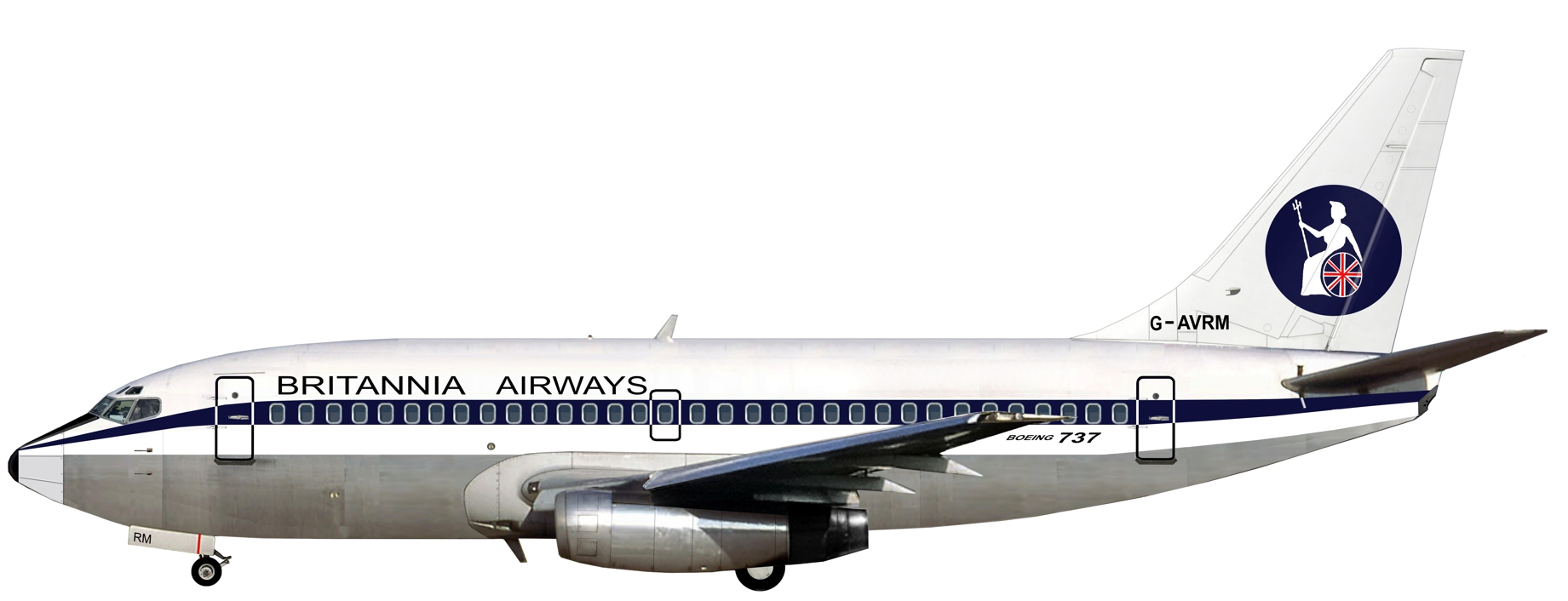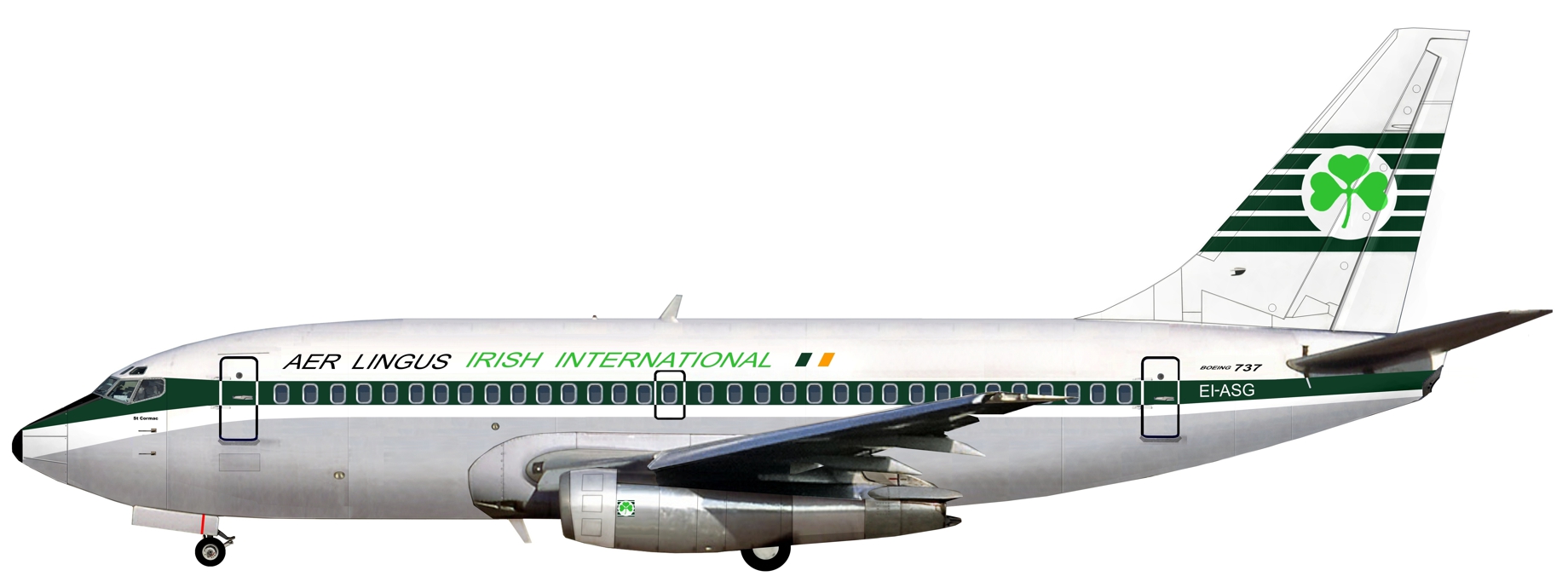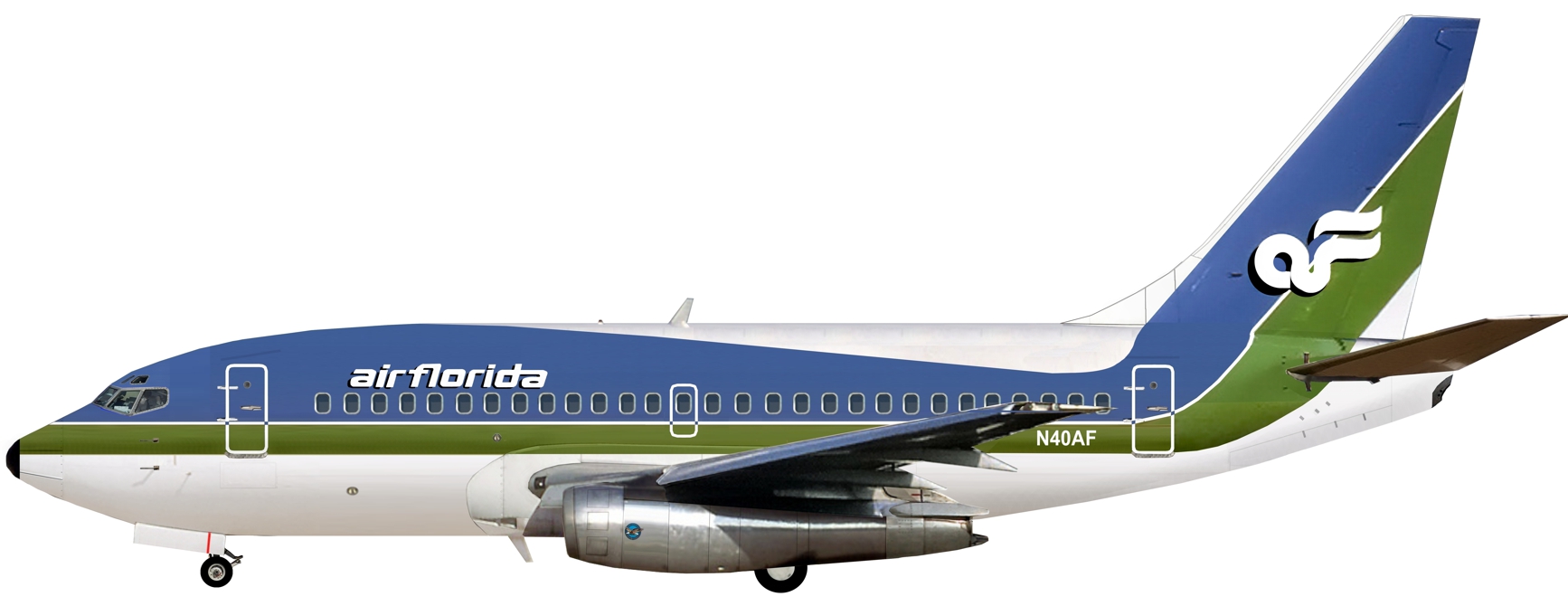
Boeing 737...................................................................................Specifications

Lufthansa was the launch customer for the Boeing 737 series 100. This aircraft, D-ABED cn 19016, was first flown on 20th January 1968 and spent twenty four years in service with the German airline, being sold off in 1982. She is seen here as she appeared at Paris Orly airport on 1st of December 1980.
First flown on the 9 April 1967 the "Baby Boeing" was almost immediately very popular with both passengers and crew. It had the same cockpit and the same cabin diameter as the 707 and 727 before it; a concept which was pleasing to airlines as it made crew training and interchanging much easier. Also there was a certain comonolity in spare parts between the three Boeing models. Only 29 (plus 20 non commerical types) series 100s were built being delivered mostly to the launch customer Lufthansa in Germany, first flying in service on 10 February 1968. The 200 series, which entered service on 28 April 1968 with United Airlines in the USA, had a 6ft longer fuselage, and many other refinements. It was built in far greater numbers; over 1,000 airframes were delivered. The 200 series was bettered in 1971. The advanced, as it became known had better engines. It first flew with All Nippon Airways in June 1971. The 737-200 was also offered with an unpaved runway kit, available as an option during assembly. Many original B737-200Cs were fitted with a gravel deflector "ski" and vortex dissipator on the engine intake to allow rough-field operations. By the close of production in 1988 1,144 100/200 aircraft had been delivered.
All JT8D-powered B737s can meet
Chapter 2 / Stage 2 noise requirements. However, some early aircraft
require acoustical treatment to their engine cowlings to comply. As delivered,
B737s cannot meet the stricter requirements of Chapter 3 / Stage 3, but
hushkits are available for most engine / airframe combinations that allow
compliance. Some of these are subject to MTOW and landing flap restrictions.
Although several re-engining programmes have been suggested for the JT8D-powered
B737 using either the RR Tay 670, IAE V2500, CFM56, and P&W JT8D-200, no firm
programme currently exists. US and European legislation now makes it very
difficult to register non-hushkitted B737s in these regions and ultimately
the operation of such aircraft was banned from 2002 onwards.
The following organisations have developed and secured STCs for Chapter 3 /
Stage 3 hushkits:
AvAero, wholly owned by Aviation Equipment Inc, has developed two
hushkits for the JT8D-powered B737. The basic "sticker price" for the AvAero
hushkits is $1.3m, although the actual price depends on various factors
including the version of the hushkit, delivery period, and the quantity ordered.
AvAero customers included Access Air, AirTran Airways, Arkia Israeli Airlines,
Avensa, Bahamasair, Boeing, Canadian Airlines International, Casino Express,
Cayman Airlines, First Air, L'Aeropostale, Pacific Trans Air, Princess Airlines,
Royal Cargo, Sierra Pacific Airlines, Southwest Airlines, Vanguard Airlines,
WestJet Airlines, several private executive operators, and a number of aircraft
leasing companies. In total, AvAero has sold 150 hushkits.
The NORDAM Group, a privately owned company based in Tulsa, Oklahoma,
worked in conjunction with Pratt & Whitney and Boeing to develop three
generations of hushkits (HGW, LGW and LGW-H) for the JT8D-powered B737. Only the
LGW-H kit is still available.
Customers and operators included 9 Lives Holding, Aerolineas Argentinas, Air
Caribbean, Air Mediterranee, Air New Zealand, AirTran Airways, All Nippon
Airways, Delta Air Lines, Euralair International, European Aviation, European
Capital Corporation, Frontier Airlines, GE Capital Aviation Services, Indigo
Aviation AB, Interlease Aviation Corp, Islandsflug HF, LocaLease, Lufthansa,
Royal Air Maroc, Ryanair, Ryan International, TACA International Airlines,
United Airlines, US Airways, Vanguard and the US Government (T-43A).
During the 1980s the 737 was further developed. The CFM56 big fan was to be the basis of a re-engined 737 in a couragous move which was to mean even more success for the type. This 737 heraled a completely new generation of the twin Boeing with a two man cockpit and brand new avionics. The basic 737 fuselage was stretched. A new tail fin was developed and the aircraft recieved new wings and undercarriage. In order to accomodate the big engines under the wings the air intakes were ovaled out sideways.
The 737-300 first flew in 1984 and entered service with Southwest Airlines in December 1984. The aircraft carries up to 149 passengers, as oppose to 115 passengers in the 200 series. It has a range of 4,973 km with 128 passengers and maxium fuel capacity. Similar to the range of the 200.
More models of this new generation 737 appeared with different fuselage lengths. The series 500 had a fuselage equivalent in length to the 737-200, 101 ft 9 in, while the 400 series had a length of 119ft 7 in being fitted out with a tail bumper as standard to prevent damage by over rotation during take-off.
Now, development of this key aircraft has been taken even further in the shape of yet another new generation, the 600/700/800/900 series launched in 1993. The first aircraft entered service in 1998, Basically this new development incorporates a brand new wing design, improving fuel capacity and increasing aerodynnamic effciency and thus extending range and pay load. Aircraft range in size from the 600 which is 102 ft 6in long and can carry between 110 and 132 passengers over a sector of 5,649 km, and the 900 series, the to date largest of the 737 family, with a length of 138 ft 2 in, which can carry up to 189 passengers, and has a maxium range of 5,084 km. The series 800 even features 8ft winglets and flew in this form in May 2000 in the colours of the German carrier Hapag-Lloyd. The key to the success of this new generation of 737 is that it can fly very high, up to 35,000 ft, thus giving a smoother ride and saving on fuel.
The Boeing 737 has become the best selling jetliner of all time. 737s have since the first flight in 1967 carried the equivalent of the worlds population, approximately 6.1 billion passengers.

This 737-204 was delivered new to Britannia Airways on the 9th of August 1968 and shows the earlier shorter engine nacelles. These were removed after aerodynamic refinements were found necessary to accomodate the new thrust reversers. The orginal clamshell thrust reversers incorporated from the Boeing 727 were found to be ineffective with the 737's under wing engine configuration. All aircraft built prior to cn 135, including G-AVRM, were retrofitted to the new standard in March 1969. G-AVRM is shown here as she appeared at Manchester Ringway airport on the 29th of June 1969.

Boeing 737-248 EI-ASG, St.Cormac was delivered to Aer Lingus new on the 20th of February 1970, Flying with the airline until 1991. She was scrapped in 1995. Note the longer engine nacelles and modifyed engine thrust reversers which became standard after cn 135. She is pictured here, in the older Aer Lingus livery, as seen during August 1974 at Paris Le Bourget airport, France.

This Boeing 737-112 displays the shorter fuselage of the series as originally ordered by 737 launch customer Lufthansa. N40AF started life as 9V-BBC of Malaysia-Singapore Airlines, being first flown on the 21st of February 1969. She found her way to Air Florida on the 16th of May 1979. She has since been put into storage for spares after going to Faucett of īPeru in 1988. She is seen here in this very colourful livery as she appeared at New York JFK on the 6th of April 1980.